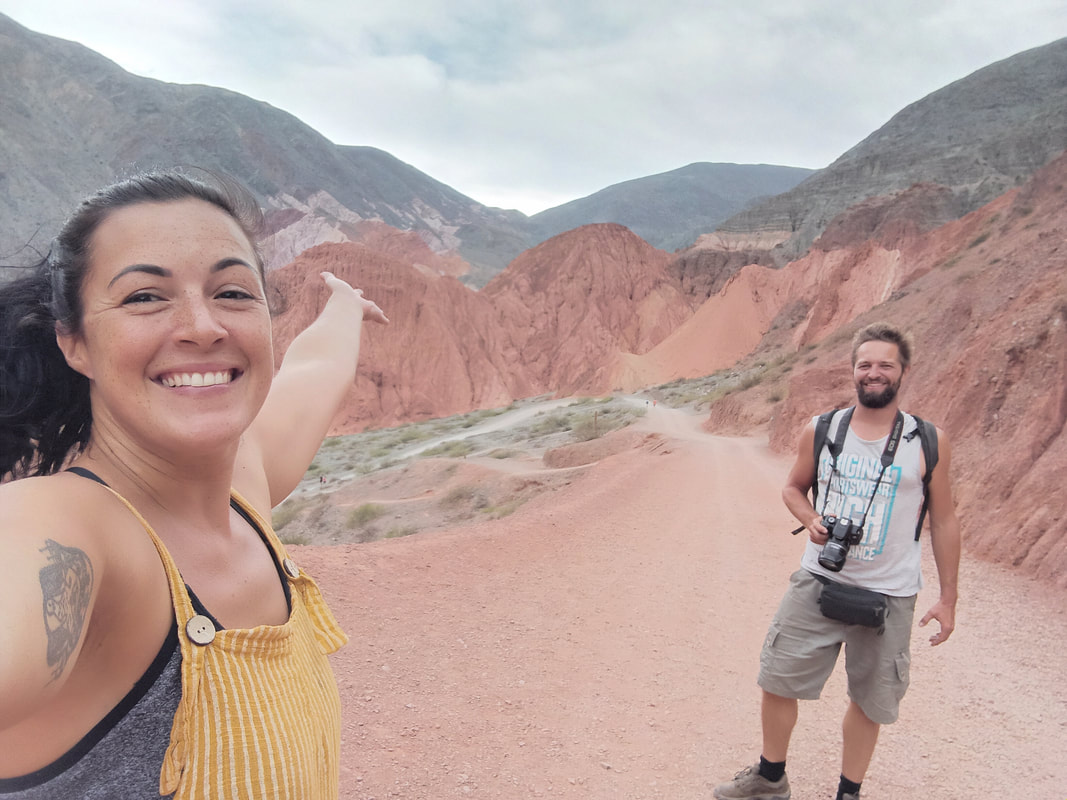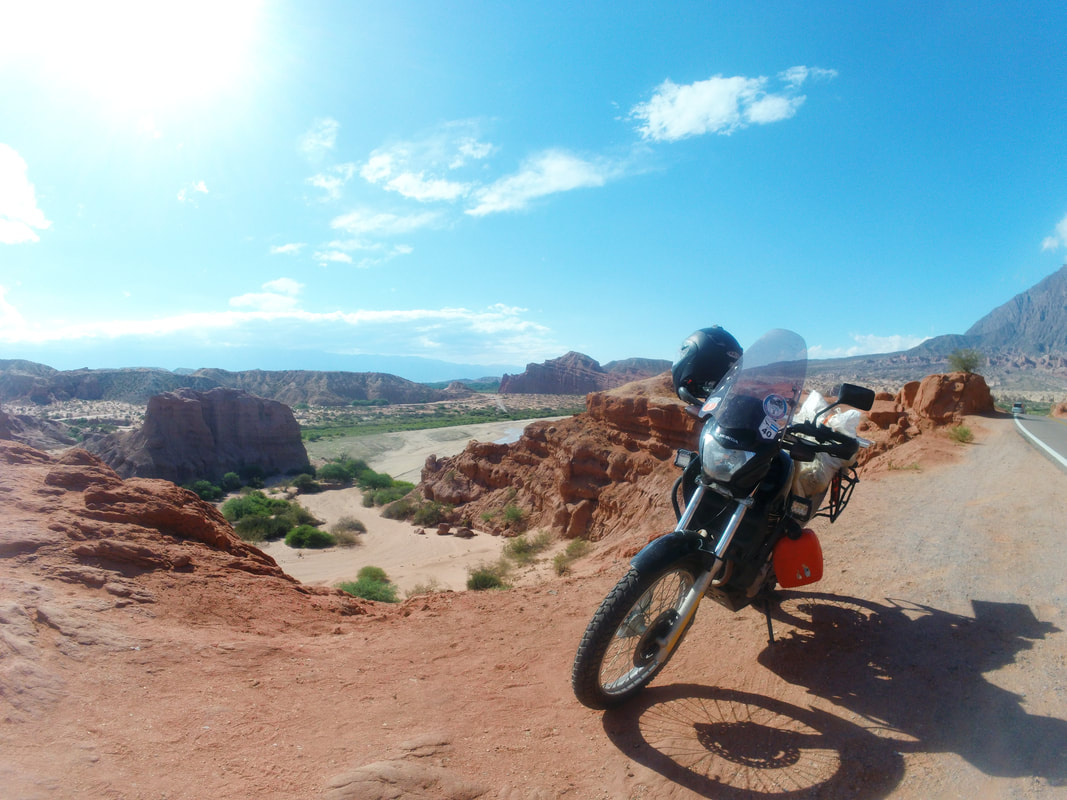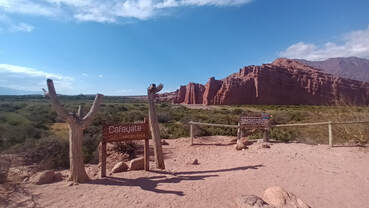Exploring Northern Argentina
What if I told you we discovered some of the most mind-blowing scenery imaginable while crossing Argentina? When we left Paraguay, we drove for over three days through flatlands and pampas with little to focus on, so when we finally arrived in Cafayate in Northern Argentina, we were gobsmacked. Truth be told, Dennis had a few places marked, which I had not looked into, so I had no idea what to expect, and little did I know that this place would be more than we could imagine.
On our way there, we stopped by Termas de Honda known for its thermal springs and stayed at a campsite where we picthed our tent beside over 6 pools, which we had all to ourselves. From here, we continued to the archeological site of Quilmes, a fascinating former urban settlement that tells a somber story. Dating from about AD 1000, Quilmes was a complex indigenous urban settlement that occupied about 30 hectares and housed as many as 5000 people. The inhabitants survived contact with the Inca, which occurred from about AD 1480 onward, but could not outlast the siege of the Spanish, who in 1667 deported the remaining 2000 to Buenos Aires. The story of the deportation of this calm and nonviolent group was heart-wrenching, yet this site exists today to keep the culture of the Quilmes people alive, which I very much appreciate.
We passed by glorious vineyards, backed by the Andes mountains as we approached Cafayate, and boy was it stunning. We planned to stay here for a few days to explore the area - a place known for its red rocks and surreal landscape, but little did we know that it would give the USA National Parks a run for their money. Not only was the town of Cafayate, which is located in the province of Salta, a great place to wander around, shop, or have drinks and dinner, but once we got to the outskirts of the town, we couldn't believe what we saw.
We took the motorbike and headed for The Calchaqui Valley, which is an area known for its stunning rock formations. It is best known for its contrast of colors and its unique geography, which ranges from the mountain desert to the subtropical forest. As the road winded around the towering rock formations, another surprise awaited us around each corner, and we couldn't help but grin from ear to ear. We spent the entire afternoon driving Ruta 68, an impressively scenic road, which for me was one of the most beautiful landscapes I had seen in a long time. Little did we know Argentina would continue to surprise us.
On our way there, we stopped by Termas de Honda known for its thermal springs and stayed at a campsite where we picthed our tent beside over 6 pools, which we had all to ourselves. From here, we continued to the archeological site of Quilmes, a fascinating former urban settlement that tells a somber story. Dating from about AD 1000, Quilmes was a complex indigenous urban settlement that occupied about 30 hectares and housed as many as 5000 people. The inhabitants survived contact with the Inca, which occurred from about AD 1480 onward, but could not outlast the siege of the Spanish, who in 1667 deported the remaining 2000 to Buenos Aires. The story of the deportation of this calm and nonviolent group was heart-wrenching, yet this site exists today to keep the culture of the Quilmes people alive, which I very much appreciate.
We passed by glorious vineyards, backed by the Andes mountains as we approached Cafayate, and boy was it stunning. We planned to stay here for a few days to explore the area - a place known for its red rocks and surreal landscape, but little did we know that it would give the USA National Parks a run for their money. Not only was the town of Cafayate, which is located in the province of Salta, a great place to wander around, shop, or have drinks and dinner, but once we got to the outskirts of the town, we couldn't believe what we saw.
We took the motorbike and headed for The Calchaqui Valley, which is an area known for its stunning rock formations. It is best known for its contrast of colors and its unique geography, which ranges from the mountain desert to the subtropical forest. As the road winded around the towering rock formations, another surprise awaited us around each corner, and we couldn't help but grin from ear to ear. We spent the entire afternoon driving Ruta 68, an impressively scenic road, which for me was one of the most beautiful landscapes I had seen in a long time. Little did we know Argentina would continue to surprise us.
Having had our fill of delicious food and wine in Cafayate, and incredible scenery, we continued on towards the beautiful city of Salta, where we took the time to get the bike maintained and source Western Union funds yet again (see my blog about the Blue Dollar) and eventually to Purmamarca - home of the Hill of Seven Colours. We were starting to think that Northeastern Argentina was giving Argentinian Patagonia a run for its money.
Purmamarca was a place that blew our minds yet again. Here we were in a town that was similar to something from a Wild West movie, surrounded by colorful mountains of all shapes and sizes. The streets were dusty, the atmosphere was calm, and there was a lot to discover on foot - which is what we did. We explored the famous Hill of Seven Colours by hiking to a nearby viewpoint which gave us the best view, and the following day, we embarked on a circular trail around the colorful rock region, which was just as impressive around every corner.
While staying in Purmamarca, we went out to eat, starting with a delicious regional restaurant that served regional specialties like Cafayate wine, barbequed llama, and goat, which we both tried. The following day, we tried a local pizzeria that was highly recommended on our beloved app, 'iOverlander,' and it did not disappoint. Purmamarca was a gem in the crown of North Argentina, and we could easily have spent a few more days exploring the area.
Purmamarca was a place that blew our minds yet again. Here we were in a town that was similar to something from a Wild West movie, surrounded by colorful mountains of all shapes and sizes. The streets were dusty, the atmosphere was calm, and there was a lot to discover on foot - which is what we did. We explored the famous Hill of Seven Colours by hiking to a nearby viewpoint which gave us the best view, and the following day, we embarked on a circular trail around the colorful rock region, which was just as impressive around every corner.
While staying in Purmamarca, we went out to eat, starting with a delicious regional restaurant that served regional specialties like Cafayate wine, barbequed llama, and goat, which we both tried. The following day, we tried a local pizzeria that was highly recommended on our beloved app, 'iOverlander,' and it did not disappoint. Purmamarca was a gem in the crown of North Argentina, and we could easily have spent a few more days exploring the area.
So, this was it. The time had come to leave Argentina (or so we thought) and make our way to Chile to visit San Pedro de Atacama Desert, and to Bolivia from there. From Purmamarca we drove across some stunning passes, one of which reached 4,070m and onwards to Jama, which bordered Chile. It was beginning to get late and we still had another three or so hours to make it across the Jama Pass - one of the highest roads in South America, and arrive in San Pedro De Atacama.
We wondered if we should stay the night at the YPF (gas station) hotel, but when the rooms were fully booked, we decided to go for it (and what a silly mistake this was). Our last few minutes in Argentina were beautiful, as the sun set and the landscape lit up golden around us, but once the sun went down, we found ourselves going higher and higher into the mountains as the temperature began to plummet - and as our bike threatened to give up due to the extremely high altitude. We were beginning to think, we made the wrong decision to just 'go for it'.
Stay tuned for the Chile blog to see what happens next.
We wondered if we should stay the night at the YPF (gas station) hotel, but when the rooms were fully booked, we decided to go for it (and what a silly mistake this was). Our last few minutes in Argentina were beautiful, as the sun set and the landscape lit up golden around us, but once the sun went down, we found ourselves going higher and higher into the mountains as the temperature began to plummet - and as our bike threatened to give up due to the extremely high altitude. We were beginning to think, we made the wrong decision to just 'go for it'.
Stay tuned for the Chile blog to see what happens next.







